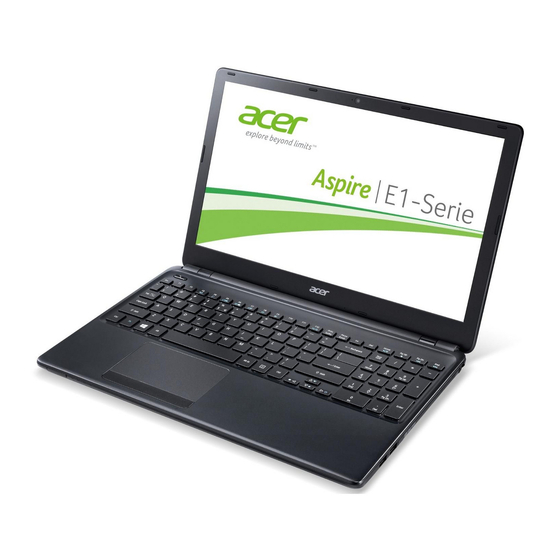Summarization of Contents
Safety and Comfort
Guidelines for safe battery usage
Precautions for safe usage, charging, and handling of the Lithium-ion battery.
TIPS AND INFORMATION FOR COMFORTABLE USE
Tips for comfortable and productive computer usage to prevent strain.
First Things First
Basic care and tips for using your computer
Essential advice for maintaining the computer's performance and longevity.
Taking care of your computer
Essential precautions to protect the computer from damage and environmental factors.
Your Acer Notebook Tour
Screen view
Identifies and describes the components visible on the screen and front bezel.
Keyboard view
Identifies and describes the components of the keyboard and touchpad area.
Left view
Identifies and describes the ports and slots located on the left side of the notebook.
Right view
Identifies and describes the ports and features located on the right side of the notebook.
Base view
Identifies and describes the components located on the bottom of the notebook.
Using the Keyboard
Hotkeys
Details on using function key combinations for various system controls.
Touchpad
Touchpad basics
Explains how to use the touchpad for cursor control and selection.
Touchpad gestures
Describes various multi-finger gestures for navigation and control.
Recovery
Creating a recovery backup
Step-by-step guide to create a system recovery backup on a USB drive.
Recovering your system
Overview of methods to restore the computer to a previous state or factory condition.
Returning your system to its factory condition
Procedures to reset the computer to its original factory state.
Recovering from Windows
Steps to restore the system using built-in recovery tools within Windows.
Power Management
Disable Fast startup
Instructions to disable the fast startup feature to save battery power.
Battery Pack
Charging the battery
Steps for correctly charging the computer's battery pack.
Optimizing battery life
Tips and suggestions to maximize the battery's operational time.
Traveling with Your Computer
Preparing the computer
Guidance on preparing the computer for moving or traveling.
Traveling internationally with the computer
Specific advice for traveling with the computer across countries.
Securing Your Computer
Using passwords
Information on setting Supervisor and User passwords for system security.
Connecting to a Network
Built-in network feature
How to connect to an Ethernet-based network using the RJ-45 port.
Wireless Networks
Connecting to the Internet
Steps to connect the computer to the internet using its wireless capabilities.
BIOS Utility
Setting passwords
Procedures for setting boot passwords within the BIOS utility.
Frequently Asked Questions
I turned on the power, but the computer does not start or boot up
Troubleshooting steps for power-on or boot-up issues.
Nothing appears on the screen
Solutions for a blank screen, possibly due to power saving.
Tips and hints for using Windows 8
Guidance on navigating and using features specific to the Windows 8 operating system.
Troubleshooting
Error messages
Table listing common error messages and their corresponding corrective actions.
Regulations and Safety Notices
FCC STATEMENT
Compliance statement regarding FCC regulations for digital devices.
The FCC RF safety requirement
Details on RF exposure limits and safe usage distances for wireless components.
















Need help?
Do you have a question about the Aspire E1-530G and is the answer not in the manual?
Questions and answers